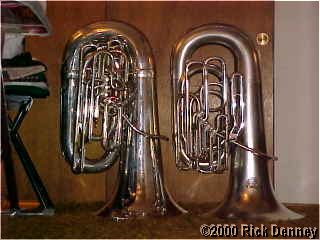
Posted by not exactly on October 21, 2002 at 19:18:16:
In Reply to: Re: Re: Re: Re: Re: Holton 6/4 BBb - Update posted by Sooo on October 21, 2002 at 17:37:03:

What I was saying is "most folks who complain about these horns are either basing their opinion on a) play-testing in a limited, non-ensemble capacity for a limited period of time or b) just repeating something they heard."
Also, that mostcomplaints about intonation in the Grand-Orchestral CC tuba often seem to be based upon cut horns, which exacerbate the natural tendencies of any CC tuba - tendencies which incidentally are more pronounced the larger a horn gets.
You are reading a bit more into the discussion than is actually there, but you are cettainly entitled to your own opinion. One thing's for sure though you'll not hear me saying the old tubas were optimized for much of anything in one key or t'other, they were/are just big!! I DID say that the Grand Orchestral CC's built new today ARE more consistent than their heritage BBflat counterparts - and if you think of it, that implies a lot of modern-day thinking (like process control and mass production) which were not really thought of yet 75-100 years ago.
Some comments about the silly "cut" versus "uncut" controversy? If you can produce a horn with a character of sound that is not available anywhere else, why not? When the other horn in the foto was built up by Bob Rusk, NO ONE made a great play-able CC tuba like the Marzan-styled Bohm & Meinls, a big American-style 5/4 horn. Even the CC B&Ms produced then were wonderful sounding but had a lot of clam notes. Mr. Rusk took a great BBflat horn, brand new, and cut it and finished it to the order of a Chicago tuba-student in the 80's. Even today, the most recent MW 2155 is the closest current example, but it's been in development almost as long as it took for the 2165's (and the HB50's) to get it right. And in the case of a 2155, it still costs 2-3 grand more to get than a B&M like mine. Far as I am concerned, thass 'nuff said there. As to whether there is a "good" reason today to "cut" a horn, I can give you one example which is consistent with my obvious preference, and well-enough refutes yours, at least for me! That example: I am looking at a couple of early 60's BATs, one is a three-valve bell-front and the other a 4-valve BBflat. Between the two (and with addition of some new parts like a valve set and a bell), I hope to wind up with two nice horns, a nice bell-front CC for use in outdoor settings, as well as a nice clean properly-assembled Grand Orchestral BBflat! Why the bell front? My BAT (pictured here, the one on the left next to a certain CUT-from-BBflat Bohm & Meinl) was originally built for another tubist in Chicago. Interestingly it is also the same tuba measured and used by Gerhard Meinl when he got serious about the MW2165 project in 1990. Anyways, this certain CSO tubist wanted a CC bell-front to overcome weaknesses in recording technology of the late 60's. When he saw that the horn being made for him was bell-up, he was miffed, and arranged for one of his Northwestern students to get this tuba. 28 years later, I bought it, and I just want a sister horn for it - the way Mr. Jacobs wanted, bell-front and CC !! If the project works out, great! If not, the other BBflat 4-valver (with a brand new bell) will help defray the expense of such folly.
f.w.i.w. & rgds,
dp